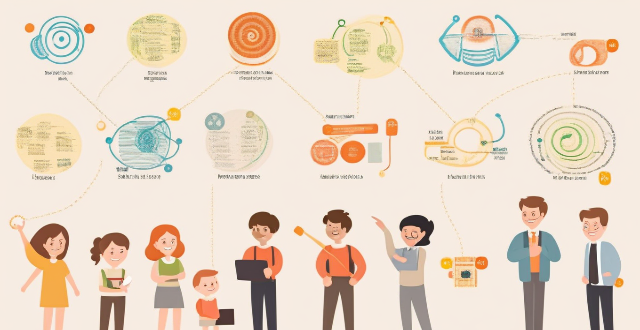Education Virtual

What impact does virtual reality have on education ?
Virtual reality (VR) is a rapidly evolving technology that has the potential to revolutionize the way we learn and teach. It offers an immersive, interactive experience that can engage students in new and exciting ways. In this article, we will explore the various impacts of virtual reality on education. One of the most significant benefits of VR in education is its ability to create realistic simulations. These simulations allow students to experience complex concepts and scenarios that would be difficult or impossible to replicate in a traditional classroom setting. For example, medical students can practice surgical procedures without risking harm to real patients, while history students can explore ancient civilizations and witness historical events firsthand. VR also increases student engagement by making learning more interactive and fun. Instead of passively listening to lectures or reading textbooks, students can actively participate in their learning through immersive experiences. This increased engagement can lead to better retention of information and improved academic performance. With the rise of online education, VR can provide students with access to resources and opportunities that may not be available in their local area. Students can attend virtual field trips, visit museums and historical sites, and even attend classes at prestigious universities from anywhere in the world. VR also has the potential to make education more inclusive for students with disabilities or those who may struggle in traditional classroom settings. For example, students with social anxiety can practice public speaking in a safe, controlled environment, while those with physical disabilities can participate in activities that may be otherwise inaccessible. VR allows students to work on projects together in a virtual space, fostering collaboration and teamwork skills. They can create 3D models, design virtual environments, and even program their own games or applications. This type of hands-on learning encourages creativity and problem-solving skills. VR also enables global collaboration between students from different countries and cultures. Students can work together on projects, share ideas, and learn from one another in real-time. This exposure to diverse perspectives can broaden their understanding of the world and prepare them for success in an increasingly globalized workforce. While the potential benefits of VR in education are numerous, there are also challenges and considerations that must be addressed. These include cost, technical requirements, health concerns, and educational effectiveness. A balanced approach that incorporates both technologies is essential for optimal outcomes.

In what ways can virtual reality be utilized for medical training and therapy ?
Virtual reality is revolutionizing medical training and therapy by providing immersive, interactive experiences that simulate real-world scenarios. In medical training, VR offers hands-on practice in a safe environment, multisensory learning experiences, interactive anatomy education, and tools for surgical planning and collaboration. In therapy, it is used for pain management, motor skills rehabilitation, cognitive rehabilitation, mental health treatment, specialized interventions like ASD therapy, and neurorehabilitation. The potential of virtual reality in healthcare is vast, with ongoing technological advancements expected to bring further innovations in this field.

How do virtual classrooms compare to traditional classrooms in terms of learning effectiveness ?
The text presents a comparative analysis of virtual classrooms and traditional classrooms in terms of learning effectiveness. The comparison is structured around several aspects: 1. **Learning Environment**: Traditional classrooms offer physical interaction but limited resources, while virtual classrooms provide flexibility and access to diverse resources. 2. **Teaching Methods**: Direct instruction and group work are emphasized in traditional settings, whereas interactive tools and personalized learning are characteristic of virtual environments. 3. **Student Participation**: Active participation and social dynamics are key in traditional classrooms, while virtual settings allow for asynchronous participation and cater to introverted students. 4. **Assessment and Feedback**: Immediate feedback and formative assessment are strengths of traditional classrooms, while automated feedback and summative assessment are advantages of virtual classrooms. 5. **Conclusion**: The choice between traditional and virtual classrooms depends on various factors, and an ideal approach could be a blended method that combines the best elements of both.

How has virtual reality technology been incorporated into sports equipment ?
The integration of virtual reality technology into sports equipment has revolutionized the way athletes train, perform, and recover from injuries. It also enhances fan engagement by providing unique perspectives of live sporting events. The main applications include simulation and training, performance analysis, rehabilitation and recovery, and fan engagement.

How are virtual reality and augmented reality changing the way we experience entertainment ?
Virtual reality and augmented reality technologies are revolutionizing entertainment by offering immersive, interactive, and personalized experiences. They have impacted various domains of entertainment, including gaming, movies, sports, and music. VR headsets provide an immersive gaming experience, while AR games bring gaming into the real world. VR cinema offers an immersive movie-watching experience, and AR applications enhance the viewing experience by adding virtual elements to the real world. Sports fans can enjoy a more immersive experience with VR platforms and AR applications that display real-time statistics and replays. Virtual concerts and AR-enhanced performances offer unique and personalized music experiences. Overall, these technologies make entertainment more engaging and enjoyable than ever before.

How does climate change influence the future of remote work and virtual employment ?
The article discusses the impact of climate change on the future of remote work and virtual employment. It states that rising temperatures, extreme weather events, and environmental concerns are driving factors for the shift towards remote work arrangements. As a result, there is an increasing demand for remote work options, technology advancements to support virtual employment, and a changing work culture that focuses on results rather than physical presence. The article concludes that embracing these changes can lead to a sustainable and efficient future of work.

How can virtual reality be incorporated into sports training and performance enhancement ?
Virtual reality is revolutionizing sports training and performance enhancement by offering a safe, controlled environment for skill development, tactical analysis, mental preparation, rehabilitation, and team building. Athletes can practice skills in realistic simulations, receive immediate feedback, repeat movements without fatigue, visualize game plans, engage in interactive scenarios, analyze opponents, develop mindfulness techniques, visualize success, manage distractions, manage pain during rehabilitation, recover motor functions, receive mental health support, foster camaraderie through shared experiences, enhance communication through role playing, and promote mutual respect among diverse players. As virtual reality technology advances, it will become an integral part of future sports training programs.

Can virtual exercise classes help elderly people stay socially active during isolation periods like lockdowns ?
Virtual exercise classes can be beneficial for elderly people during isolation periods, promoting social connections and physical health while being adaptable to different needs. However, challenges such as technology barriers, lack of personalized attention, and motivation must be addressed to ensure effectiveness and accessibility.

What are the benefits and drawbacks of virtual fan support events compared to in-person events ?
Virtual fan support events provide global accessibility, cost-Virtual fan support events provide global accessibility, cost- benefits but face challenges like limited cost-effectiveness, and safety benefits but face challenges like limited personal interaction and technical issues. Finding a balance between virtual and in-person events is crucial for meaningful connections.

How can we incorporate climate education into the school curriculum ?
Incorporating climate education into the school curriculum is crucial for preparing future generations to face the challenges posed by climate change. The strategies for integrating climate education include a cross-curricular approach, real-world applications, project-based learning, guest lectures and workshops, technology integration, critical thinking and problem solving, global perspectives, artistic expression, policy and advocacy, and continuous assessment. These approaches engage students across disciplines and prepare them for active participation in addressing one of the most pressing issues of our time.

What are the benefits of using a remote education platform for learning ?
Using a remote education platform for learning offers numerous benefits that enhance the overall learning experience, including flexibility and convenience, personalized learning, collaboration opportunities, cost savings, access to quality education, improved learning outcomes, and environmental sustainability.

What role does technology play in modern home education ?
Technology has revolutionized modern home education by providing enhanced learning opportunities, personalized experiences, and facilitating parent-child collaboration. Online courses, educational apps, virtual reality, adaptive learning software, interactive whiteboards, and gamification are just some of the tools used to create engaging and effective learning environments. Additionally, video conferencing, online communities, and digital portfolios help parents stay connected and involved in their child's education. Technology will continue to play a significant role in shaping home education practices in the future.

Can remote education platforms replace traditional classroom learning ?
The text discusses the pros and cons of remote education platforms and concludes that they cannot fully replace traditional classroom learning due to lack of social interaction, difficulty with self-motivation, and limited hands-on experience. However, a combination of both methods may provide a well-rounded education.

What role does technology play in modern education systems ?
The text discusses the role of technology in modern education systems, highlighting its ability to enhance accessibility, personalize learning experiences, improve collaboration and communication, refine assessment methods, and facilitate lifelong learning. It also acknowledges potential challenges such as the digital divide, overreliance on technology, and data privacy concerns. The conclusion emphasizes that while technology offers numerous opportunities for education enhancement, it should be integrated thoughtfully to avoid potential pitfalls.

How can we make climate education more engaging for students ?
To make climate education more engaging for students, educatorTo make climate education more engaging for students, educator methods, technology and multimedia integrate the subject across the curriculum, foster curiosity, and connect with local issues and opportunities.

What is the role of technology in enhancing the international education experience ?
Technology plays a pivotal role in enhancing the international education experience by fostering connectivity, providing access to information, enabling interactive learning experiences, and promoting cultural exchange. With tools like email, video conferencing software, and social media platforms, students can connect and collaborate with peers globally. Online resources such as e-books, databases, and MOOCs offer vast amounts of information previously only accessible through physical means. Interactive learning experiences are made possible through multimedia tools like virtual reality, augmented reality, and gamification. Finally, technology promotes cultural exchange through language exchange platforms, virtual exchange programs, and social media exposure to diverse perspectives. As technological advancements continue, they will undoubtedly further shape the future of international education.

What changes have been made to the curriculum due to the recent education policy updates ?
The recent education policy updates have brought significant changes to the curriculum, including a focus on core subjects, inclusion of 21st century skills, increased flexibility and choice, integration of technology, assessment reform, and promotion of lifelong learning. These changes aim to enhance the quality of education, improve student outcomes, and prepare students for the challenges of the future.

How can technology be used to enhance learning for students with special education needs ?
Technology can significantly enhance learning for students with special education needs by offering personalized experiences, accessibility features, collaboration tools, data-driven insights, and safety/mental health support.

What are the challenges and opportunities for online international education during the COVID-19 pandemic ?
The COVID-19 pandemic has disrupted many aspects of our lives, including education. With schools and universities closed, online international education has become the new norm. However, this shift to online learning comes with its own set of challenges and opportunities. One of the biggest challenges is technical issues, as many students may not have access to reliable internet connections or devices that can support online learning. Another challenge is language barriers, which can lead to feelings of isolation and exclusion from the learning community. Additionally, online learning can lack face-to-face interaction, which is essential for building relationships and fostering a sense of community among students. Despite these challenges, online international education also presents several opportunities. One major opportunity is accessibility, as online education allows students from all over the world to access quality education without having to leave their homes. Another opportunity is flexibility, as online courses often allow students to work at their own pace and on their own schedule. Finally, online international education provides an opportunity for diversity, as students from different backgrounds and cultures can come together in one virtual classroom. In conclusion, while online international education presents several challenges during the COVID-19 pandemic, it also offers numerous opportunities for students around the world. By addressing the challenges and embracing the opportunities, we can make online education a more effective and enjoyable experience for all learners.

What role do technology and online learning play in advancing women's education ?
Technology and online learning have revolutionized the education sector, providing unprecedented opportunities for learners worldwide. For women, these advancements are particularly significant, addressing historical barriers to education and creating a more inclusive learning environment. The integration of technology and online learning has significantly advanced women's education by offering accessibility, promoting equality, empowering economically, personalizing learning experiences, building supportive communities, and overcoming sociocultural challenges.

How has virtual reality technology evolved over the past few years ?
Over the past few years, VR technology has significantly evolved, transforming from a niche to a mainstream platform for gaming, education, and various applications. Key developments include hardware improvements such as lighter designs and higher resolution displays; software advancements like enhanced graphics and expanded content libraries; and application expansion into fields like healthcare and architecture. Future outlooks suggest further innovations in wireless connectivity and hybrid reality integration.

How do these education policy updates align with global education standards ?
Education policy updates align with global education standards in various ways, including curriculum reform, diverse assessment methods, teacher professional development, technology integration, and prioritizing student well-being and inclusivity. These efforts aim to equip students with the necessary skills and knowledge to thrive in a globalized world.

What are the trends and predictions for the future of international education ?
The future of international education is expected to be shaped by a range of trends and predictions, including: 1. **Increased Demand for Global Learning**: A rise in student mobility and diverse programs catering to specific interests. 2. **Technology-Enabled Learning**: Greater integration of online resources and blended learning models. 3. **Cultural Competence and Global Citizenship**: Emphasis on intercultural skill development and global citizenship education. 4. **Collaborative Partnerships and Exchanges**: More institutional partnerships and multinational collaborations. 5. **Sustainability and Social Impact**: Green campuses and community engagement initiatives. 6. **Personalized Learning Pathways**: Customized education and enhanced career services. 7. **Policy Changes and Regulation**: Potential shifts in visa policies and quality assurance standards. 8. **Financial Aid and Scholarships**: Expanded funding opportunities and alternative financing methods. 9. **Language Diversity**: Recognition of multilingualism and linguistic inclusivity. 10. **Lifelong Learning**: Adaptation of degree programs for non-traditional students and a focus on continuing education.

How will these education policy updates impact the future of education in our society ?
Education policy updates may increase access to education, emphasize STEM education, and improve student outcomes.

What is the role of gamification in education, and what tools support it ?
Gamification plays a pivotal role in education by making learning more engaging and effective. It enhances student engagement, promotes active learning, increases motivation, fosters competition and collaboration, provides real-time feedback, adapts to individual needs, and makes learning fun. Numerous tools and platforms support the implementation of gamification in education, such as BadgeOS, Classcraft, Kahoot!, Duolingo, Quizizz, and Manga High. These tools demonstrate how gamification can be integrated into various subjects and age groups, making education more dynamic and engaging for students. By leveraging these platforms, educators can transform traditional classrooms into exciting learning environments that prepare students not just academically but also for future workplaces where many industries are adopting gamified approaches to training and development.

What role do education systems play in promoting scientific literacy among women ?
Education systems play a crucial role in promoting scientific literacy among women by providing equal access to education, encouraging female teachers, offering extracurricular activities, addressing gender bias, and providing mentorship programs.